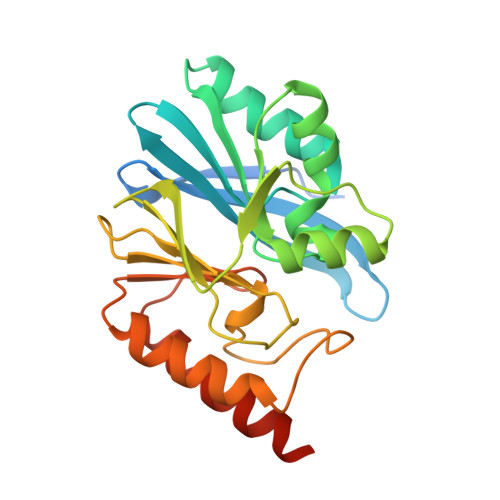Structural insights into the substrate specificity of IMP-6 and IMP-1 metallo-beta-lactamases.
Yamamoto, K., Tanaka, H., Kurisu, G., Nakano, R., Yano, H., Sakai, H.(2022) J Biochem 173: 21-30
- PubMed: 36174533
- DOI: https://doi.org/10.1093/jb/mvac080
- Primary Citation of Related Structures:
7XHW, 7XHX - PubMed Abstract:
IMP-type metallo-β-lactamases confer resistance to carbapenems and a broad spectrum of β-lactam antibiotics. IMP-6 and IMP-1 differ by only a point mutation: Ser262 in IMP-1 and Gly262 in IMP-6. The kcat/Km values of IMP-1 for imipenem and meropenem are nearly identical; however, for IMP-6, the kcat/Km for meropenem is 7-fold that for imipenem. In clinical practice, this may result in an ineffective therapeutic regimen and, consequently, in treatment failure. Here, we report the crystal structures of IMP-6 and IMP-1 with the same space group and similar cell constants at resolutions of 1.70 and 1.94 Å, respectively. The overall structures of IMP-6 and IMP-1 are similar. However, the loop region (residues 60-66), which participates in substrate binding, is more flexible in IMP-6 than in IMP-1. This difference in flexibility determines the substrate specificity of IMP-type metallo-β-lactamases for imipenem and meropenem. The amino acid at position 262 alters the mobility of His263; this affects the flexibility of the loop via a hydrogen bond with Pro68, which plays the role of a hinge in IMP-type metallo-β-lactamases. The substitution of Pro68 with a glycine elicited an increase in the Km of IMP-6 for imipenem, whereas the affinity for meropenem remained unchanged.
- Department of Chemistry, Nara Medical University, 840 Shojo-Cho, Kashihara, Nara 634-8521, Japan.
Organizational Affiliation:

















